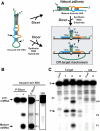Short RNA duplexes guide sequence-dependent cleavage by human Dicer
- PMID: 20974746
- PMCID: PMC2995407
- DOI: 10.1261/rna.2346510
Short RNA duplexes guide sequence-dependent cleavage by human Dicer
Abstract
Dicer is a member of the double-stranded (ds) RNA-specific ribonuclease III (RNase III) family that is required for RNA processing and degradation. Like most members of the RNase III family, Dicer possesses a dsRNA binding domain and cleaves long RNA duplexes in vitro. In this study, Dicer substrate selectivity was examined using bipartite substrates. These experiments revealed that an RNA helix possessing a 2-nucleotide (nt) 3'-overhang may bind and direct sequence-specific Dicer-mediated cleavage in trans at a fixed distance from the 3'-end overhang. Chemical modifications of the substrate indicate that the presence of the ribose 2'-hydroxyl group is not required for Dicer binding, but some located near the scissile bonds are needed for RNA cleavage. This suggests a flexible mechanism for substrate selectivity that recognizes the overall shape of an RNA helix. Examination of the structure of natural pre-microRNAs (pre-miRNAs) suggests that they may form bipartite substrates with complementary mRNA sequences, and thus induce seed-independent Dicer cleavage. Indeed, in vitro, natural pre-miRNA directed sequence-specific Dicer-mediated cleavage in trans by supporting the formation of a substrate mimic.
Figures






Similar articles
-
Cryo-EM structures of human DICER dicing a pre-miRNA substrate.FEBS J. 2024 Jul;291(14):3072-3079. doi: 10.1111/febs.17048. Epub 2024 Jan 10. FEBS J. 2024. PMID: 38151772 Review.
-
Unknown Areas of Activity of Human Ribonuclease Dicer: A Putative Deoxyribonuclease Activity.Molecules. 2020 Mar 20;25(6):1414. doi: 10.3390/molecules25061414. Molecules. 2020. PMID: 32244942 Free PMC article.
-
Sequence determinant of small RNA production by DICER.Nature. 2023 Mar;615(7951):323-330. doi: 10.1038/s41586-023-05722-4. Epub 2023 Feb 22. Nature. 2023. PMID: 36813957
-
Two-step cleavage of hairpin RNA with 5' overhangs by human DICER.BMC Mol Biol. 2011 Feb 9;12:6. doi: 10.1186/1471-2199-12-6. BMC Mol Biol. 2011. PMID: 21306637 Free PMC article.
-
Dicer-independent processing of small RNA duplexes: mechanistic insights and applications.Nucleic Acids Res. 2017 Oct 13;45(18):10369-10379. doi: 10.1093/nar/gkx779. Nucleic Acids Res. 2017. PMID: 28977573 Free PMC article. Review.
Cited by
-
MicroRNA-570 targets the HSP chaperone network, increases proteotoxic stress and inhibits mammary tumor cell migration.Sci Rep. 2022 Sep 16;12(1):15582. doi: 10.1038/s41598-022-19533-6. Sci Rep. 2022. PMID: 36114410 Free PMC article.
-
The catalytic efficiency of yeast ribonuclease III depends on substrate specific product release rate.Nucleic Acids Res. 2016 Sep 19;44(16):7911-21. doi: 10.1093/nar/gkw507. Epub 2016 Jun 1. Nucleic Acids Res. 2016. PMID: 27257067 Free PMC article.
-
Novel RNA molecular bioengineering technology efficiently produces functional miRNA agents.RNA. 2024 May 16;30(6):680-694. doi: 10.1261/rna.079904.123. RNA. 2024. PMID: 38429100 Free PMC article.
References
-
- Carbonell A, Martinez de Alba AE, Flores R, Gago S 2008. Double-stranded RNA interferes in a sequence-specific manner with the infection of representative members of the two viroid families. Virology 371: 44–53 - PubMed
-
- Carmell MA, Hannon GJ 2004. RNase III enzymes and the initiation of gene silencing. Nat Struct Mol Biol 11: 214–218 - PubMed
Publication types
MeSH terms
Substances
Grants and funding
LinkOut - more resources
Full Text Sources
Research Materials
